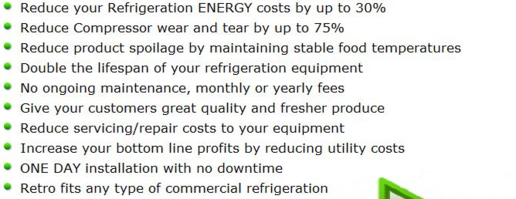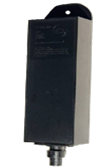Proven Energy Cost Saving Solutions for
Residential and Commercial Clients
866-520-0202
We need distributors Worldwide
Click on "Distributors Needed"
Tab Above
TOP TEN REASONS TO INSTALL THE ENDOCUBE IN YOUR WALK INS, COOLERS AND OTHER REFRIGERATION UNITS
Fact Sheet
Revolutionary and simple control device for commercial refrigeration
Low-cost device fits on the existing temperature sensor which controls the compressor based upon ambient air temperature
Endocube controls the compressor based upon product temperature
Fridges installed with this device see compressor starts and stops less frequently and longer compressor cycles saving electricity without compromising food safety
Improves efficiency of commercial fridges and freezers by between 15% and 35%
Technology Payback – 2 to 12 months based purely on energy consumption
Launched in the UK and United States in 2007 - wide circulation and high customer sat-isfaction
Significant energy savings (reduced electricity bills and Demand Charges/Climate Change Levy Charges)
Considerable noise reduction
Reduced wear and tear on equipment, leading to extended life of equipment
Fewer breakdowns
Fewer sensor failures (as sensors are protected inside the Endocube);
Safer food and less product spoilage
Reduced environmental pollution
One-time retrofit product requiring no further attention or maintenance once fitted
Lower temperatures achieved without heat induced defrost cycles.
Bottom Line: Low Cost device which significantly reduces power consumption (up to 35%) and also limits wear on compressor, saving you money in the short- and long-term
THE PROBLEM:
How refrigeration units work:
Refrigeration units work in a series of cycles measuring the air in and around the product they cool. All units will start and stop to maintain a pre-set required storage temperature. Refrig-eration unit thermostats usually monitor circulating air temperature in order to decide when to switch on and off. Circulating air temperatures tend to rise far more quickly than food tem-peratures when fridges are opened and closed. As a result, refrigeration units work much harder than necessary to maintain stored products at the right temperature as prescribed by the thermostat. Air cycles (on/off) typically produce a minimum of 12 cycles per hour, and in some open display cases, 20 cycles per hour. This leads to excessive electricity consumption and undue wear and tear on the equipment, resulting in higher energy bills, shorter equip-ment life spans and an exaggerated impact on the environment (both through higher rates of energy consumption and the implication of disposing of refrigeration units with a shorter life-span).
Refrigeration is one of the 3 main drivers of energy consumption for many businesses. It is es-timated that twenty percent of the world’s global energy is used by refrigeration. As Time of Use (TOU) Rates continue to spiral upwards, businesses of all sizes need to find ways to save energy and money. In addition to air conditioning, the biggest challenge is to address electric-ity loads from refrigeration in grocery stores, pubs and corner stores. For each of these types of businesses, refrigeration is a major expense and a driver of summer peak load.
THE SOLUTION:
In early 2000, a new device called the Endocube was launched in the UK. The Endocube is an innovative device that fundamentally changes the existing theories around refrigeration.
How the Endocube works:
The Endocube dramatically changes the way a refrigerator operates because it measures the product temperature instead of the air temperature around the product. As circulating air temperature tends to rise far more quickly than food temperature, refrigerator units tend to work much harder than necessary to maintain stored products at the right temperature. When fitted to the thermostat sensor, which controls the compressor, the Endocube significantly re-duces the frequency of the refrigeration cycles as they are now based on food temperature rather than fluctuating air temperature. By using the Endocube as a cycle control mechanism, refrigeration cycles last longer but can be reduced by as much as 80%.
The Endocube consists of a non-toxic wax food simulant contained in a double-skinned enclo-sure. The food simulant mimics food temperature at around 10mm below the surface and is designed to fit quickly and easily around the fridge’s temperature sensor. With the cube fitted, the fridge responds only to the temperature of the food, and prevents fluctuating air tempera-tures from spontaneously starting the unit. It is like having your thermostat regulating fridge temperature by the temperature of the yogurt, instead of the constantly fluctuating air tem-perature. This means the compressor cycles less often than the door is open and closed, con-serving electricity. The Endocube ensures that refrigeration keeps food at the correct tem-perature while drastically limiting the temperature cycling (and resulting consumption) driven by the opening and closing of refrigerators and freezers.
For example, a Dairy Case air cycles 3 minutes on, 2 minutes off = 12 cycles per hour. With an Endocube fitted, the cycles change to 8 minutes on, 7 minutes off = 4 cycles per hour. This equates to a 66.7% reduction in starts.
As the start-up of a refrigerator compressor uses 3 times more power (i.e. 12 amps to start-up / 4 amps to run) considerable energy savings are achieved. In addition, the more efficient refrigeration cycle lease to a more efficient unit, which then leads to a colder storage area. By adjusting the thermostat back to its normal temperature settings, there are further substantial energy savings. Food safety and quality are not compromised.
When you consider more than half of the electricity in a grocery store is used to run fridges and freezers, you can imagine the impact these devices will have. The largest energy saving will be realized in the large freezers and the open chill cabinets used in the catering and super-market industries. Additional savings will accrue based on the extended lifespan of starting devices, refrigeration equipment as well as fewer break downs and service calls.
The Endocube has been rolled out in the UK with great initial success. Green King, one of the largest pub owners in the UK is installing Endocubes and will save 3.5 million pounds a year in electricity costs, about 20% for each refrigerator that the Endocube is installed in. The payback on investment will range from 2 to 12 months according to studies in the UK. Details of UK-based studies can be found in the attached Endocube energy data.
Installation is SIMPLE & EASY!
The Endocube is installed to cover the control probe(s) of a refrigeration unit, in order to pre-vent temperature fluctuations. Once installed, the fridge runs only as the product tempera-ture requires it, saving electricity and compressor wear and tear. Installation is as simple as screwing the Endocube onto the sensor.
FAQ's
Q: "What’s inside Endocube?"
A: Endocube contains a patented, high molecular weight, aliphatic hydrocarbon compound. The substance is inert, non-toxic, and approved by the NSF for usage with any refrigerator or freezer.
Q: "How do I know this is safe for my product?"
A: Endocube was actually invented as a food safety device, and it was only accidentally dis-covered that it saves energy as well. Endocube is NSF approved as a food safety device and there is an NSF logo on every Endocube sold, so customers can feel comfortable that their product is at least as safe (or even safer) than it was before. In NSF studies, the Endocube actually achieved a more consistent product temperature over time (i.e., less fluctuations).
Q: "How does Endocube know what type of product is in the case?"
A: How does a thermostat know whether it contains hot or cold liquid? It’s the same
principle. Endocube does not "know" what is in the case, it simply insulates the probe with a patented compound that is similar to most foods.In other words, there is much less of a difference between the thermodynamic properties of "Endocube vs. product," than there is between the thermodynamic properties of "air vs. product."
Q: "Will installing Endocube void my warranty?"
A: No. Manufacturers warranty is for defects in materials or workmanship, neither of
which are affected by Endocube. Endocube has no mechanical or electrical parts and is therefore "non-invasive" to the refrigeration system. There is functionally no difference be-tween installing an Endocube and changing the usage pattern of the cooler or freezer.
Q: "We already have a food monitoring system."
A: There are some stand-alone food monitoring systems that allow customers to drop a de-vice into a case that transmits food temperature back to a monitoring system. The important thing to focus on is that Endocube also does that but pays for itself. So, Endocube is a self-financing food monitoring system, which puts it way ahead of the competition.
Q: "How does this work with a pressure system?"
A: It can work with a pressure system, if they have thermostats in the cases and
reconfigure the system to regulate refrigeration supply based on changes in EndoCube
temperature. Alternatively, it can simply be used as a food monitoring system, sending
product temperature back to their IT systems for each case or zone.
Q: "How does Endocube affect the temperature inside the refrigerator or freezer?"
A: Endocube usually lowers the air ("case") temperature due to more efficient cooling and, to com-pensate for this new lower temperature, the thermostat setting is adjusted upward. In other words, Endocube achieves the same air temperature with a higher set point, thus saving energy.
Endocube is a simple device that fits over the thermostat probe on a refrigerator or freezer. Inside Endocube is a material that has been proven by the NSF to mimic the properties of food and beverages. Now, rather than responding to rapidly fluctuating air temperature, Endocube allows the unit to respond to food temperature instead.
Endocube provides the existing thermostat with product temperature instead of air tem-perature, a more accurate measurement. This more accurate and stable temperature causes the compressor to run fewer, but much longer cycles. These longer cycles create "thermal inertia" as it cools food for a longer period of time (at a more accurate tempera-ture), thereby increasing the efficiency of the unit.
So how does Endocube save you money?
Because the compressor is cycling less often (up to 80% less), the life of the compressor is extended. Since it is also operating more efficiently less energy is used. Multiple case studies have demonstrated that refrigeration units use between 10% to 30% less energy with Endocube, while maintaining the desired temperature in the unit.
Endocube is a temperature-mimicking sensor (TMS1) tested under protocol P235 by NSF International. It is designed for placement into refrigeration containing dairy, meat, ready meals and other food products meant to be maintained at or below 41°. Endocube is designed to accurately reflect the temperature of food under refrigeration conditions and warm more quickly than food products upon equipment failure. (1TMS is a seperate, non-invasive device consisting of food simulant material with a thermocouple or thermoresistor attached.)
NSF International's mission is to protect you by certifying products and writing standards for food, water and consumer goods. As an independent not-for-profit organization, NSF International's ongoing public health commitment is to encourage everyone to live safer"
Under the performance requirements of Protocol P235, Endocube has passed the following tests:
• The temperature indicated by Endocube is between ±2° F of the refrigerated food products 15mm below their surface during the normal refrigeration operations test. The purpose of the test is to ensure Endocube accurately mimics the food product temperatures.
• The temperature indicated by Endocube is no more than 2° F lower and no more than ±5° higher than the refrigerated food products during the warm up test which imitates a refrigeration failure. The purpose of the test is for endocube to indicate a higher temperature than the food products to provide advanced warning and allows users to take remedial actions





